Abstract
This study compares the amount of available biomass for wild herbivores (red deer (Cervus elaphus L.), roe deer (Capreolus capreolus L.), and hare (Lepus europaeus Pallas)) depending on three different types of forest silvicultural systems—presented using the example of beech and spruce stands in wintertime. During the winter period, spruce provided ten times more biomass for herbivores than beech. However, beech provided more metabolizable energy, 7.38 MJ/kg on average, whereas spruce only provided 6.57 MJ/kg. From the point of view of “risk of damage by herbivores”, artificial regeneration suffered the worst damage after using the Clear Cutting method of forest regeneration, as there was the least amount of biomass available, and thus, herbivores caused the greatest damage. On average, 12% of shoots were damaged in clearings. Most at risk was young forest vegetation up to 1 m tall. In summer, the area was overgrown with available plants, but in winter, the herbivores focused mainly on eating woody shoots. Damage to the natural regeneration when using the Shelterwood Cutting and Strip Cutting regeneration methods ranged up to 3%. At the same time, a high amount of available biomass was measured there, most likely due to its frequent natural regeneration. Thus, both types of trees regenerated in this way were not as susceptible to damage by herbivores as when regenerated using the Clear Cutting method.
1. Introduction
In addition to their production and many non-production functions, forest stands also play an irreplaceable role in the herbivore environment, providing shelter and food. Herbivores contribute to some extent to the environment’s diversity and stability through their feeding behavior, and imbalances between the number of animals and the food supply in the environment can lead to unfavorable development of the herbivore population, of the forest stands [1,2], and can also lead to a significant economic damage [3,4]. Forests growing under excessive grazing pressure then have a changed tree composition and lower stability and diversity [5]. Therefore, it is important to maintain herbivore populations in accordance with the carrying capacity of the specific environment. It is very difficult or sometimes even impossible to set the carrying capacity limits. The effects of herbivores’ feeding behavior on the forest ecosystem are the result of several factors that are difficult to forecast accurately [6]. Among the external factors, most important are species composition and their food specialization, the number of individuals of the species and their distribution in the environment, the distribution of food sources and their attractiveness, the use of alternative food sources around the forest complexes, and harassment by tourists. In addition to all these influences, forest stands themselves also play a significant role in the herbivore existence impact [7,8]. In forests with developed undergrowth, providing a rich food supply of grasses and shrubs, the herbivore grazing pressure on the target woody plants is significantly lower [9,10] than in forests, where the only food sources are found on pastures and in the youngest stands [11,12]. At the same time, the critical influence of herbivores’ feeding behavior on forest stands often has great seasonal and spatial variability [13]. Animals tend to concentrate in places that are favorable to them in terms of other food sources [14], or are safe for them, and thus, there is the greatest risk of damage, while the overall damage to the forest complex is tolerable. The most critical season is winter. In winter, the availability of most alternative food sources and shelter outside the forest is limited, and animals are concentrated in the forest complexes. At the same time, the food supply is very limited in the forest environment, so animals are forced to feed to a large extent on woody plant shoots [15,16]. The most exposed stands are those up to 150 cm tall [17].
Therefore, the way forests are managed affects to a large extent both the carrying capacity for herbivores and the impact of their feeding behavior. Most important in this respect are the methods of stand regeneration that significantly affect the quantity, quality, and attractiveness of the food available to the animals [18,19]. Therefore, taking herbivore browsing pressure into consideration, when selecting a stand regeneration method, can significantly reduce the risk of damage. In the Czech Republic, most forest areas are managed commercially using artificial (76.4%) and natural (23.6%) regeneration (see Data Availability Statement). The most commonly used methods of regeneration are Clear Cutting, Strip Cutting, and Shelterwood Cutting.
The amount of available food is a crucial factor that directly determines the usable environment capacity for herbivores, and also indirectly determines the intensity of forest damage by browsing. Throughout the year, the amount of available biomass and its quality changes significantly. As has already been established, the critical period for both herbivores and forests is the end of winter, when food supplies may be depleted, and hungry animals switch to emergency food and cause great damage to forest stands. For these reasons, this study focused on the available biomass of winter shoots. The aim of this work was to compare the Clear Cutting, Strip Cutting, and Shelterwood Cutting methods of forest regeneration in terms of woody plant shoot availability for herbivores in winter, and the risk of damage by herbivore browsing.
Study Hypotheses
- The regeneration method will significantly affect the amount of available biomass, where the smallest amount of biomass will result from using the Clear Cutting method, and the relatively lowest number of woody plants per unit area will be expected.
- The largest amount of biomass available to herbivores will be young vegetation with low side branches.
- The highest browsing damage will occur when using the Clear Cutting method due to the small number of woody plants in the area.
2. Materials and Methods
2.1. Study Area
The study area was in the forest stands in the Drahanska Highlands (49°18′52.793′′ N; 16°51′26.564′′ E), Czech Republic, at the altitude of approximately 500 m above sea level. There were spruce (Picea abies (L.) H. Karst.) and beech (Fagus sylvatica L.) forests with three types of silvicultural systems, with natural and artificial regeneration. The area had similar terrain parameters (maximum inclination was up to 5°). The studied types of forest environment were sufficiently represented in the monitored locality, as shown in Figure 1.
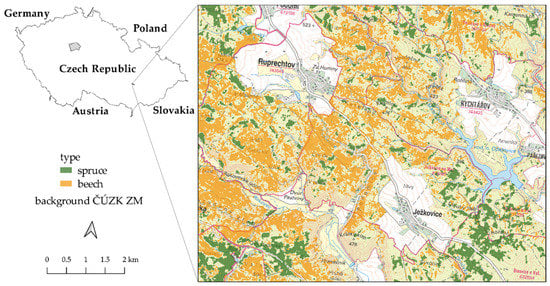
Figure 1.
Map of the study area with spruce and beech stands distinguished using remote sensing (nDSM images).
2.2. Biomass of Shoots
The data on the available biomass of woody plant shoots and their damage by herbivores were collected in areas with three different types of silvicultural systems (Clear Cutting with artificial regeneration, Strip Cutting, and Shelterwood Cutting with natural regeneration) and with two types of trees (spruce and beech).
The stands, in which the sampling plots were located, were sorted according to type of silvicultural system, type of regeneration, type of trees, coverage (%), and average tree height (at 1 m intervals). Biomass was determined for a total of 164 sampling plots, and each plot was 1 m2 in size. There was only one tree species on each sampling plot, and there were at least 20 sampling plots in each stand type. (Table 1).

Table 1.
Number of sampling plots, in which the biomass weight of shoots was determined.
The amount of biomass available for large herbivores was estimated by cutting all available biomass of woody plant shoots, up to height of 0.5 m, and between 0.5 and 2 m, during the winter. The biomass was collected, simulating the natural feeding behavior of herbivores. The maximum length of the collected shoots was 5 cm. The shoots biomass was cut only in the plots without any sign of previous browsing, or in the fenced plots. On each sampling plot, tree coverage (%), number of trees, and their height (cm) were measured. Then, the shoots in the plots were pruned and subsequently weighed. Tree vegetation coverage and height was also measured in all stand types. To compare the weight of biomass among the monitored types of forest environment, first, the weight of trimmed shoots from individual sampling plots was recalculated to 100% canopy of present trees within the sampling plot (kg/m2). Next, the weight of biomass thus calculated was multiplied by the value of tree coverage from the relevant stand type, and converted to an area of one hectare (kg/ha). The biomass samples were dried at 105 °C, and dry matter content was determined. The dried samples were ground and homogenized, basic nutritional value parameters were determined, and metabolizable energy content was estimated.
2.3. Woody Plants Damage Intensity
At the end of winter, the intensity of woody plants damage in 135 transects was determined. The transects were 1 m wide, and there were at least 30 trees on each of them. The transects were located in each type of examined unfenced forest stand (beech or spruce; natural or artificial regeneration; Clear Cutting or Strip Cutting or Shelterwood Cutting system), with a height of 0.1 to 1.3 m. For each tree in the transect, its height (cm) was measured, and the total number of shoots and the number of browsed shoots in this winter season were counted. Thus, the proportion of damaged shoots in individual trees (spruce or beech) was determined.
2.4. Presence of Herbivores
In order to detect the presence of herbivores, the amount of herbivore fecal pellets was monitored after winter in March, on 1 m wide and 50 m long strip transects (115 transects), evenly distributed across the study area. The presence of brown hare, red deer, and roe deer was detected.
2.5. Statistical Methods
STATISTICA 8 software (Palo Alto, CA, USA) and Microsoft Office Excel-2003 were used for statistical data processing. The normality of the data was tested using the Shapiro–Wilks test and normal probability graphs. The data were then evaluated by a parametric test on the agreement of variances 1F ANOVA, or by a t-test. If the data did not meet the assumption of normality, the hypotheses were tested by non-parametric Kruskal–Wallis or Mann–Whitney U-test. To assess the significance of individual factors, post hoc tests such as Tukey’s HSD test for unequal N were used. For non-parametric data, multiple comparison tests of p values were used for data satisfying normality. Interdependencies of factors were determined on the basis of correlation and regression analyses. In all statistical analyses, a significance level of α = 0.05 was determined.
3. Results
3.1. Biomass of Shoots
The amount of biomass available for large herbivores differed significantly (p < 0.05) among the two tree types, the vegetation height groups, and the different methods of regeneration.
Figure 2 shows the amount of usable biomass by silvicultural system. Figure 3 shows the amount of usable biomass for herbivores increased for vegetation height of 3 m. As regards trees taller than 3 m, usable biomass measured up to 2 m decreased for both beech and spruce.
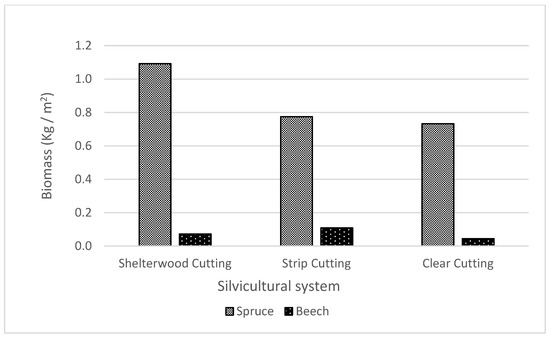
Figure 2.
Amount of usable biomass of trees up to two meters tall, according to silvicultural system.
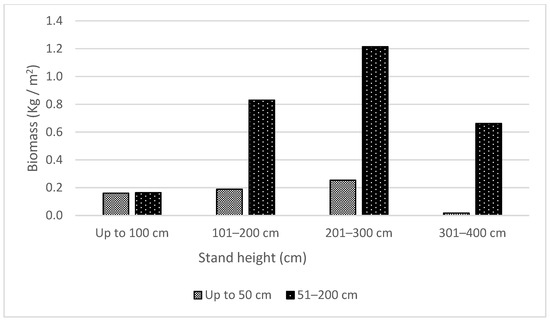
Figure 3.
Amount of usable biomass according to height of spruce stand.
The largest weight of available biomass was found in stands using natural regeneration (Figure 4). For beech, it was in the Strip Cutting silvicultural system, in the height category of up to two meters (913 kg/ha on average). For spruce, it was in the Shelterwood Cutting silvicultural system, in the height category of up to four meters (12,799 kg/ha on average) (Figure 5). In the stands where the Clear Cutting silvicultural system was used, the amount of available biomass of shoots was significantly (p < 0.05) lower. For beech, the maximum biomass was in the height category of up to three meters (461 kg/ha on average). For spruce, the maximum biomass was in the height category of up to four meters (12,051 kg/ha on average).
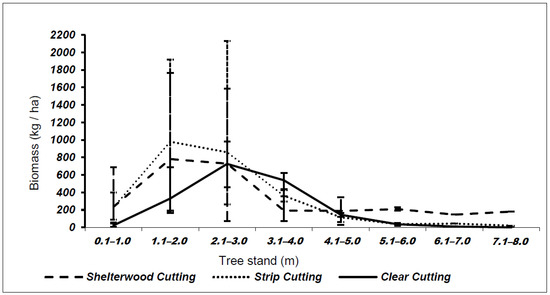
Figure 4.
Average weight of available biomass in beech stands regenerated using Shelterwood Cutting, Strip Cutting, and Clear Cutting according to height.

Figure 5.
Average weight of available biomass in spruce stands regenerated using Shelterwood Cutting, Strip Cutting, and Clear Cutting according to height.
Vegetation height had a significant (p < 0.05) effect on the amount of biomass, as the highest amount of biomass is in the crown. The amount of the most easily available biomass, up to 50 cm from the ground, remained the same up to a height of three meters. Then, the lower branches died, and the usable biomass was practically no longer present up to this height. The biggest decrease in biomass according to vegetation height was in beech stands using Shelterwood Cutting and Strip Cutting systems with natural regeneration. This was also due to the high tree density, where the lower branches dry up quickly. When regenerated using the Clear Cutting method, the difference in height categories was low for both beech and spruce stands. However, for both monitored tree types and all the methods of regeneration, the amount of available biomass was lower in old stands with a height of over five meters than in young stands. At the same time, spruce stands offered significantly more biomass than beech, and there was not a significant (p > 0.05) difference in the regeneration origin, but there was a (p < 0.05) significant difference in the weight of spruce biomass in silvicultural systems in young stands (1–3 m high). On the other hand, spruce offered large amounts of biomass for a much longer time than beech.
Compared to beech trees, spruce shoots had a lower dry matter content and at the same time, a lower nutritional value. The average dry matter content was 50.72% for spruce shoots and 58.86% for beech shoots. The total nutritional value using metabolizable energy content was estimated to be 6.57 MJ/kg on average for spruce, and 7.38 MJ/kg on average for beech. When converting metabolizable energy content to the amount of vegetation biomass, the difference between spruce and beech stands was still huge (spruce stands offered 18,854 MJ/ha on average, while beech stands offered only 2025 MJ/ha on average).
3.2. Woody Plants Damage Intensity
The method of vegetation regeneration also had a significant effect (p < 0.05) on the browsing intensity of shoots. The average browsing intensity in the stands with Shelterwood Cutting and those with Strip Cutting were similar—2.03% and 2.55%, respectively. In the stands regenerated using the Clear Cutting method, the browsing intensity of the shoots was the highest, being 12.84% on average (Figure 6). In all the monitored locations, large herbivores were represented in similar numbers. The average number of fecal pellet groups per m2 was 0.97 ± 0.2 for roe deer, and 0.11 ± 0.06 for red deer.
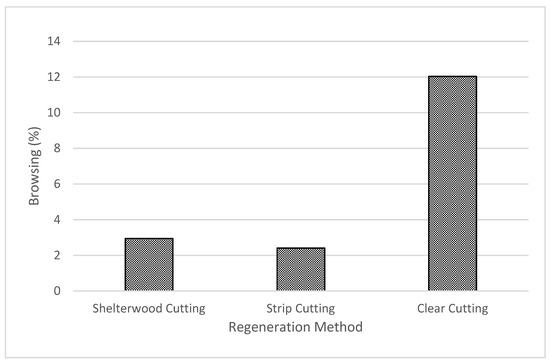
Figure 6.
Comparison of the browsing intensity in stands regenerated using Shelterwood Cutting, Strip Cutting, and Clear Cutting.
4. Discussion
As knowledge of potential browsing damage caused by herbivores is crucial, the assessment of environment capacity has already been the subject of a number of studies. Homolka and Heroldová [20], or Feuereisel and Ernst [21] focused on the weight of available biomass in the past. These authors collected biomass by cutting, either whole plants or only shoots, on test plots sized 0.5 × 0.5 m, or 1 × 1 m, up to height of 1.5, 2.0, or 2.5 m. They also recorded the coverage of vegetation communities in large areas (5 × 5 m or 10 × 10 m), or even in entire stands, and determined the weight of fresh biomass and its dry matter. Feuereisel and Ernst [21] also evaluated the nutritional value of the collected biomass by laboratory methods.
The obtained biomass data in this study are consistent with the previous studies. For example, in Austria, Reimoser and Gossow [19] found that the usefulness of the forest environment in winter is 52% to 88% lower than in the growing season. In the USA, this difference was confirmed by Johnson et al. [22]. Katreniak [23] determined that the average amount of available biomass of woody plant shoots for herbivores in winter, and in beech forest up to the age of 20 years, was 85.5 kg/ha. In their study, only 20% of the shoots were analyzed, and the total biomass of the shoots was around 427 kg/ha; however, it fully corresponds to our results. A slightly higher biomass was found for hornbeam–oak forest (926.25 kg/ha) and beech–oak forest (530 kg/ha) [23]. Approximately ten times more biomass (5750 kg/ha) was detected in a similar type of stand in the summer [20]. Similarly, Homolka and Heroldová [20] measured a total of 3775 kg of spruce shoots per hectare in the winter, in a 15-year-old artificially grown spruce stand. In a 15 to 20-year-old stand, biomass was 933 kg/ha, and in a 25-year-old stand, there were only 165 kg of spruce shoots per hectare. It is clear from the results that the amount of biomass available to herbivores is much smaller in winter than in summer. Biomass quality and availability are also important [24], and in winter, biomass consists mainly of shoots and tree needles [16]. On average, they have a lower nutritional value than leaves. From the point of view of “animal nutrition,” it is also important whether sufficiently nutritious woody plant types are available for food, such as soft deciduous trees, or if the animals are forced to feed on larger woody plants, or even big branches with some proportion of bark and bast. The importance of woody plants for herbivores depends on the animals’ body size [25], where small species are able to feed on small amounts of vegetation; it also depends on food specialization, where grass eaters can feed on grass biomass on meadows, or from additional feeding. Homolka [26] found 40% of woody plants in red deer’s winter diet in the Drahanska Highlands, 53% in the Beskydy Mountains, and 61% in the Jeseniky Mountains. The same author states that in the Jeseniky Mountains, in the summer, the share of woody plants in red deer’s diet is only 1.5%, and in the Beskydy Mountains, in the summer, it is 6%. As regards roe deer that barely use grasses as food, woody plants make up more than 65% of their diet in winter, and 75% or more of their diet during the growing season [26,27]. The highest proportion of woody plants was in the diet of moose that do not eat grass and feed mainly on woody plant shoots, which completely dominated in their diet [28]. The low energy value of the winter food diet of ruminants results in acclimatization to this energetic challenge by means of hypothermia, i.e., reduced endogenous heat production and abandoning the maintenance of a high body temperature, particularly in peripheral body parts. Altogether, metabolic rate, estimated by continuous heart rate measurement, during winter is downregulated to more than half of the summer level [29]. Turbill et al. [30] reported metabolic rate reduction in red deer as an important physiological mechanism for energy conservation during winter, and in response to food restriction. The negative energy balance during winter is compensated by using fat reserves accumulated during summer [29].
From the point of view of “forest regeneration”, hares can also be an important species. Although they feed mainly on herbaceous vegetation during the growing season, they can switch to deciduous trees in winter when other food is lacking. An important factor influencing hares’ food composition is snow cover. Green et al. [31] found an increase in the share of woody plants up to 43% during snow cover compared to 3% in periods without snow.
The observed sharp decrease in the amount of available biomass with the increase in stand height corresponded to the drying up of lower branches. At heights of about 8 m for beech stands and 12 m for spruce stands, the weight of biomass for herbivores was already very low and occurred almost exclusively in stands with multiple ground levels. From the point of view of “herbivore nutrition in winter”, beech stands up to 4 m tall and spruce stands up to 6 m tall were the key elements. Other stands were not as important in terms of herbivore nutrition and environment capacity. Thus, herbivores are food-dependent on areas with young vegetation, which, in addition to woody plants, also offer grass and small new plants during the growing season. However, the high degree of attractiveness of these areas leads to the accumulation of herbivores in the vicinity. Therefore, the regeneration methods play an important role, as individual regeneration elements can be applied in parallel [12]. If there is plenty of food and shelter, herbivores stay there even during the winter. This can lead to a collision, as in winter, the food available in the herbaceous layer disappears under the snow, and only woody plant shoots remain. Therefore, artificially based stands on clear cuttings have a significantly greater predisposition to damage than stands created by natural regeneration.
5. Conclusions
The amount of food available in forest environments varies greatly, and vegetation height, stand usability, and seasons all have a fundamental influence.
Due to the significant differences in environments’ capacity, it would be advisable to forest management, when evaluating a particular environment capacity, to consider the size of areas with vegetation up to three meters tall, as they provide herbivores with food, even in winter. The large amount of food available in the summer is of no significance in terms of steady all-year-round herbivore occurrence, and thus there is no need to take it into account in forest management, as animals usually concentrate in forests for the winter and have to survive on the existing supply of woody plant shoots. To reduce the degree of damage to forest stands by browsing, it is demonstrably more appropriate to use silvicultural systems with natural regeneration.
Author Contributions
Conceptualization, K.T., J.K. (Jiří Kamler), V.S.; methodology, K.T.; software, J.K. (Jiří Kloz); validation, V.S. and J.K. (Jiří Kamler); formal analysis, J.K. (Jiří Kloz) and V.S.; investigation, K.T., P.N., V.S.; resources, K.T.; data curation, K.T., V.S.; writing—original draft preparation, V.S., K.T.; writing—review and editing, J.K. (Jiří Kamler); visualization, V.S.; supervision, J.K. (Jiří Kamler); project administration, K.T., V.S. All authors have read and agreed to the published version of the manuscript.
Funding
This research received no external funding.
Institutional Review Board Statement
Not applicable.
Informed Consent Statement
Not applicable.
Data Availability Statement
We used just data from literature number 20. http://nil.uhul.cz/downloads/vysledky_projektu_nil2/skody_zveri_lp_listopad_2016.pdf (accessed on 19 April 2021); Kučera, M.; Adolt, R.; Kohn, I.; Piškytlová, K.; Kratěna, L.; Fejfar, J. Outputs of the National Forest Inventory Carried Out in 2011–2015, 11. Obnova. Lesn. Práce 2016, 95.
Conflicts of Interest
The funders had no role in the design of the study; in the collection, analyses, or interpretation of data; in the writing of the manuscript, or in the decision to publish the results.
References
- Ramirez, J.I.; Jansen, P.A.; Poorter, L. Effects of wild ungulates on the regeneration, structure and functioning of temperate forests: A semi-quantitative review. For. Ecol. Manag. 2018, 424, 406–419. [Google Scholar] [CrossRef]
- Ramirez, J.I.; Jansen, P.A.; den Ouden, J.; Goudzwaard, L.; Poorter, L. Long-term effects of wild ungulates on the structure, composition and succession of temperate forests. For. Ecol. Manag. 2019, 432, 478–488. [Google Scholar] [CrossRef]
- Conover, M.R.; Butikofer, E.; Decker, D.J. Wildlife damage to crops: Perceptions of agricultural and wildlife leaders in 1957, 1987, and 2017. Wildl. Soc. Bull. 2018, 42, 551–558. [Google Scholar] [CrossRef]
- Hohbein, R.R.; Mengak, M.T. Cooperative extension agents as key informants in assessing wildlife damage trends in Georgia. Hum. Wildl. Interact. 2018, 12, 10. [Google Scholar]
- Schulze, E.D.; Bouriaud, O.; Wäldchen, J.; Eisenhauer, N.; Walentowski, H.; Seele, C.; Heinze, E.; Pruschitzki, U.; Dănilă, G.; Marin, G.; et al. Ungulate browsing causes species loss in deciduous forests independent of community dynamics and silvicultural management in Central and Southeastern Europe. Ann. For. Res. 2014, 57, 267–288. [Google Scholar] [CrossRef] [Green Version]
- Spake, R.; Bellamy, C.; Gill, R.; Watts, K.; Wilson, T.; Ditchburn, B.; Eigenbrod, F. Forest damage by hare depends on cross-scale interactions between climate, deer density and landscape structure. J. Appl. Ecol. 2020, 57, 1376–1390. [Google Scholar] [CrossRef]
- Faison, E.K.; DeStefano, S.; Foster, D.R.; Plotkin, A.B. Functional response of ungulate browsers in disturbed eastern hemlock forests. For. Ecol. Manag. 2016, 362, 177–183. [Google Scholar] [CrossRef]
- Velamazán, M.; San Miguel, A.; Escribano, R.; Perea, R. Compatibility of regeneration silviculture and wild ungulates in a Mediterranean pine forest: Implications for tree recruitment and woody plant diversity. Ann. For. Sci. 2018, 75, 35. [Google Scholar] [CrossRef] [Green Version]
- Ward, A.I.; White, P.C.; Walker, N.J.; Critchley, C.H. Conifer leader browsing by roe deer in English upland forests: Effects of deer density and understorey vegetation. For. Ecol. Manag. 2008, 256, 1333–1338. [Google Scholar] [CrossRef]
- Heinze, E.; Boch, S.; Fischer, M.; Hessenmöller, D.; Klenk, B.; Müller, J.; Prati, D.; Schulze, E.D.; Seele, C.; Socher, S.; et al. Habitat use of large ungulates in northeastern Germany in relation to forest management. For. Ecol. Manag. 2011, 261, 288–296. [Google Scholar] [CrossRef]
- Moser, B.; Schütz, M.; Hindenlang, K.E. Importance of alternative food resources for browsing by roe deer on deciduous trees: The role of food availability and species quality. For. Ecol. Manag. 2006, 226, 248–255. [Google Scholar] [CrossRef]
- Kuijper, D.P.; Cromsigt, J.P.; Churski, M.; Adam, B.; Jędrzejewska, B.; Jędrzejewski, W. Do ungulates preferentially feed in forest gaps in European temperate forest? For. Ecol. Manag. 2009, 258, 1528–1535. [Google Scholar] [CrossRef]
- Gerhardt, P.; Arnold, J.M.; Hackländer, K.; Hochbichler, E. Determinants of deer impact in European forests–A systematic literature analysis. For. Ecol. Manag. 2013, 310, 173–186. [Google Scholar] [CrossRef]
- Arnold, J.M.; Gerhardt, P.; Steyaert, S.M.; Hochbichler, E.; Hackländer, K. Diversionary feeding can reduce red deer habitat selection pressure on vulnerable forest stands, but is not a panacea for red deer damage. For. Ecol. Manag. 2018, 407, 166–173. [Google Scholar] [CrossRef]
- White, K.S.; Pendleton, G.W.; Hood, E. Effects of snow on Sitka black-tailed deer browse availability and nutritional carrying capacity in southeastern Alaska. J. Wildl. Manag. 2009, 73, 481–487. [Google Scholar] [CrossRef]
- Spitzer, R.; Felton, A.; Landman, M.; Singh, N.J.; Widemo, F.; Cromsigt, J.P. Fifty years of European ungulate dietary studies: A synthesis. Oikos 2020, 129, 1668–1680. [Google Scholar] [CrossRef]
- D’Aprile, D.; Vacchiano, G.; Meloni, F.; Garbarino, M.; Motta, R.; Ducoli, V.; Partel, P. Effects of Twenty Years of Ungulate Browsing on Forest Regeneration at Paneveggio Reserve, Italy. Forests 2020, 11, 612. [Google Scholar] [CrossRef]
- Nams, V.O.; Folkard, N.F.; Smith, J.N. Effects of nitrogen fertilization on several woody and nonwoody boreal forest species. Can. J. Bot. 1993, 71, 93–97. [Google Scholar] [CrossRef]
- Reimoser, F.; Gossow, H. Impact of ungulates on forest vegetation and its dependence on the silvicultural system. For. Ecol. Manag. 1996, 88, 107–119. [Google Scholar] [CrossRef]
- Homolka, M.; Heroldová, M. Vegetation as the food supply for game in a forest near Hostěnice. Přirodovědné Práce Ústavů Československé Akademie Věd v Brně 1990, 24, 40. [Google Scholar]
- Feuereisel, J.; Ernst, M. Verification of the food supply to game under conditions of the floodplain forest ecosystem. J. For. Sci. 2009, 55, 81–88. [Google Scholar] [CrossRef] [Green Version]
- Johnson, A.S.; Hale, P.E.; Ford, W.M.; Wentworth, J.M.; French, J.R.; Anderson, O.F.; Pullen, G.B. White-tailed deer foraging in relation to successional stage, overstory type and management of southern Appalachian forests. Am. Midl. Nat. 1995, 133, 18–35. [Google Scholar] [CrossRef]
- Katreniak, J. Food Availability for Ruminants in Winter from 1st to 5th Forest Vegetation Stage. Folia Venatoria 1992, 22, 11–21. [Google Scholar]
- Bobek, B.; Merta, D.; Furtek, J. Winter food and cover refuges of large ungulates in lowland forests of south-western Poland. For. Ecol. Manag. 2016, 359, 247–255. [Google Scholar] [CrossRef]
- Storms, D.; Aubry, P.; Hamann, J.L.; Saïd, S.; Fritz, H.; Saint-Andrieux, C.; Klein, F. Seasonal variation in diet composition and similarity of sympatric red deer Cervus elaphus and roe deer Capreolus capreolus. Wildl. Biol. 2008, 14, 237–250. [Google Scholar] [CrossRef] [Green Version]
- Homolka, M. The food niches of three ungulate species in a woodland complex. Folia Zool. 1993, 42, 193–203. [Google Scholar]
- Heroldová, M. Trophic Niches of Three Ungulate Species in the Pálava Biosphere Reserve; Institute of Landscape Ecology, Academy of Sciences of the Czech Republic: Brno, Czech Republic, 1997. [Google Scholar]
- Homolka, M. Dietary analyses in the European elk (Alces alces) with a view to its prospects in southern Bohemia. Folia Zool. 1989, 38, 21–29. [Google Scholar]
- Arnold, W. Seasonal differences in the physiology of wild northern ruminants. Animal 2020, 14, s124–s132. [Google Scholar] [CrossRef] [Green Version]
- Turbill, C.; Ruf, T.; Mang, T.; Arnold, W. Regulation of heart rate and rumen temperature in red deer: Effects of season and food intake. J. Exp. Biol. 2011, 214, 963–970. [Google Scholar] [CrossRef] [Green Version]
- Green, K.; Davis, N.E.; Robinson, W.A.; McAuliffe, J.; Good, R.B. Diet selection by European hares (Lepus europaeus) in the alpine zone of the Snowy Mountains, Australia. Eur. J. Wildl. Res. 2013, 59, 693–703. [Google Scholar] [CrossRef]
Publisher’s Note: MDPI stays neutral with regard to jurisdictional claims in published maps and institutional affiliations. |
© 2021 by the authors. Licensee MDPI, Basel, Switzerland. This article is an open access article distributed under the terms and conditions of the Creative Commons Attribution (CC BY) license (https://creativecommons.org/licenses/by/4.0/).